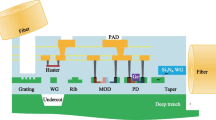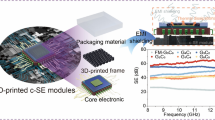Abstract
A novel and highly accurate finite-difference time-domain model is developed for bundled single-walled carbon nanotube (SWCNT) interconnects by considering a fixed configuration that consists of a CMOS driver, a bundled SWCNT interconnect system, and an optimal number of repeaters. Using superposition theorem, this iterative model is applied to the entire chain of repeaters to calculate the total closed-loop delay. An accurate transfer function is modeled for the chain of equi-spaced repeaters in the interconnect system. The transfer function is further used to develop an analytical model for closed-loop delay, considering the optimum number of repeaters as dependent parameter. Further, in order to determine the minimum delay, an analysis is performed to find out the optimum number of repeaters for a given interconnect length. In addition, a detailed study is carried out to observe the impact of interconnect length on time delay, the time delay reduction on increasing the number of repeaters and the effect of excitation magnitude on time delay with power delay product. It is observed that by using SWCNT interconnects, the total number of repeaters and the time delay are reduced by more than 40 and 50%, respectively, compared with the copper (Cu) interconnects. However, the proposed model achieves extreme accuracy, with 4% relative tolerance at maximum, in predicting interconnect performance based on comparison with the HSPICE simulations.









Similar content being viewed by others
References
A. Afrooz, Time domain analysis of field effect transistors using unconditionally stable finite difference method. IET Sci. Meas. Technol. 10(7), 686–692 (2016)
K. Afrooz, A. Abdipour, Efficient method for time-domain analysis of lossy nonuniform multiconductor transmission line driven by a modulated signal using FDTD technique. IEEE Trans. Electromagn. Compat. 54(2), 482–494 (2012)
K. Agarwal, D. Sylvester, D. Blaauw, Modeling and analysis of crosstalk noise in coupled RLC interconnects. IEEE Trans. Comput. Aided Des. Integr. Circuits Syst. 25(5), 892–901 (2006)
N.W. Ashcroft, N.D. Mermin, Solid State Physics (Saunders College, Philadelphia, 1976)
K. Banerjee, A. Mehrotra, A power-optimal repeater insertion methodology for global interconnects in nanometer designs. IEEE Trans. Electron Dev. 49(11), 2001–2007 (2002)
D. Das, H. Rahaman, Analysis of crosstalk in single- and multiwall carbon nanotube interconnects and its impact on gate oxide reliability. IEEE Trans. Nanotechnol. 10(6), 1362–1370 (2011)
R. Dhiman, R. Chandel, Dynamic crosstalk analysis in coupled interconnects for ultra-low power applications. Circuits Syst. Signal Process. 34, 21–40 (2015). https://doi.org/10.1007/s00034-014-9853-y
N. Farahat, H. Raouf, R. Mittra, Analysis of interconnect lines using the finite-difference time-domain (FDTD) method. Microw. Opt. Technol. Lett. 34(1), 6–9 (2002)
A. Giustiniani, V. Tucci, W. Zamboni, Modeling issues and performance analysis of high-speed interconnects based on a bundle of SWCNT. IEEE Trans. Electron Dev. 57(8), 1978–1986 (2010)
Y.I. Ismail, E.G. Friedman, Effects of inductance on the propagation delay and repeater insertion in VLSI circuits. IEEE Trans. Very Large Scale Integr. (VLSI) Syst. 8(2), 195–206 (2000)
B.K. Kaushik, S. Sarkar, R.P. Agarwal, R.C. Joshi, Crosstalk analysis of simultaneously switching interconnects. Int. J. Electron. 96(10), 1095–1114 (2009)
V.R. Kumar, B.K. Kaushik, A. Patnaik, An unconditionally stable FDTD model for crosstalk analysis of VLSI interconnects. IEEE Trans. Compon. Packag. Manuf. Technol. 5(12), 1810–1817 (2015)
X. Li, J. Mao, M. Swaminathan, Analysis of frequency-dependent lossy transmission lines driven by CMOS gates, in IEEE Electrical Design of Advanced Packaging and Systems Symposium (EDAPS) (Shatin, Hong Kong, 2009), pp. 1–4
H. Li, C. Xu, N. Srivastava, K. Banerjee, Carbon nanomaterials for next-generation interconnects and passives: physics, status, and prospects. IEEE Trans. Electron Dev. 56(9), 1799–1821 (2009)
X. Li, J. Mao, M. Swaminathan, Transient analysis of CMOS gate-driven RLGC interconnects based on FDTD. IEEE Trans. Comput. Aided Des. Integr. Circuits Syst. 30(4), 574–583 (2011)
F. Liang, G. Wang, W. Ding, Estimation of time delay and repeater insertion in multiwall carbon nanotube interconnects. IEEE Trans. Electron Dev. 58(8), 2712–2720 (2011)
F. Liang, G. Wang, H. Lin, Modeling of crosstalk effects in multiwall carbon nanotube interconnects. IEEE Trans. Electromagn. Compat. 54(1), 133–139 (2012)
A. Naeemi, J.D. Meindl, Carbon nanotube interconnects. Annu. Rev. Mater. Res. 39, 255–275 (2009)
A. Pal, A. Chaudhuri, R.K. Pal, A.K. Datta, Hardness of crosstalk minimization in two-layer channel routing. Integr. VLSI J. 56, 139–147 (2017)
J.D. Pursel, P.M. Goggans, A finite-difference time-domain method for solving electromagnetic problems with bandpass-limited sources. IEEE Trans. Antenna Propag. 47(1), 9–15 (1999)
C. Rutherglen, P.J. Burke, Nanoelectromagnetics: circuit and electromagnetic properties of carbon nanotubes. Small 5(8), 884–906 (2009)
A. Taflove, Computational Electrodynamics (Artech House, Norwood, 1995)
R. Venkatesan, J.A. Davis, J.D. Meindl, Compact distributed RLC interconnect models—part IV: unified models for time delay, crosstalk, and repeater insertion. IEEE Trans. Electron Dev. 50(4), 1094–1102 (2003)
Q. Xu, Z.F. Li, J. Wang, J.F. Mao, Transient analysis of lossy interconnects by modified method of characteristics. IEEE Trans. Circuits Syst. I Fundam. Theory Appl. 47(3), 363–375 (2000)
Author information
Authors and Affiliations
Corresponding author
Rights and permissions
About this article
Cite this article
Venkataiah, C., Satyaprasad, K. & Jayachandra Prasad, T. Insertion of an Optimal Number of Repeaters in Pipelined Nano-interconnects for Transient Delay Minimization. Circuits Syst Signal Process 38, 682–698 (2019). https://doi.org/10.1007/s00034-018-0876-7
Received:
Revised:
Accepted:
Published:
Issue Date:
DOI: https://doi.org/10.1007/s00034-018-0876-7




